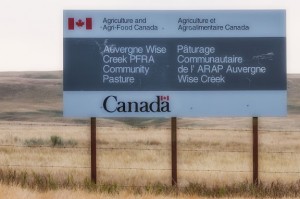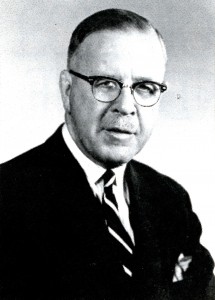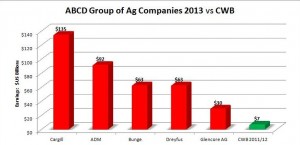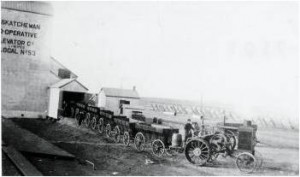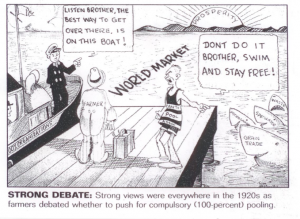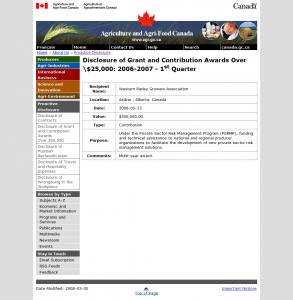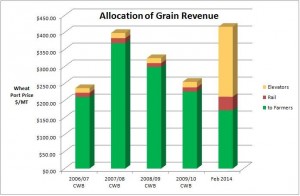Supreme Court makes second class citizens of farmers
(April 9, 2015) Today the Supreme Court of Canada rejected a Leave to Appeal by the Friends of the Canadian Wheat Board (FCWB). You can read the FCWB news release here.
What this boils down to is that in spite of the fact the single-desk Canadian Wheat Board (CWB) brand had tremendous value to farmers just as patents, like the ones Monsanto has been granted on genetics, have tremendous value to their owners, the Supreme Court has rejected allowing western grain farmers who paid for the CWB to seek compensation from Ottawa for that loss.
It escapes this writer how the learned judges of the Supreme Court could have failed to understand that every penny that went into building the CWB brand and its assets since 1935 came directly out of the Pool Accounts. In my world when you pay for something you own it, period and full stop. If someone takes it you expect fair compensation for the value of what was taken. And if it is taken without permission or compensation most people would call that “theft.”
However, Ottawa argued that “Parliament is supreme” and did not need to offer farmers compensation. The latest from the Supreme Court of Canada confirms this view. In practice this means that unless Parliament specifically authorizes compensation when they seize something, no compensation to the owners is required.
This stance strikes at the very heart of property ownership rights and natural justice. It is a wonder that today’s Ottawa Conservatives are happy with this turn of events. Joseph Stalin would be happy, Fidel Castro would be happy, but would real Conservatives like former Prime Minister John Diefenbaker who supported the single-desk and brought us the Bill of Rights agree?
From a dollars and cents point of view, this is quite a loss to western grain farmers. The first year without the single-desk Wheat Board saw the grain companies exercise their new place as middlemen between farmers and their customers and take a little over $1.7 billion dollars out of the western grain economy on # 2 CWRS wheat alone. You can get the full details on that loss here and you can see the latest loss documented here or here.
Overall farmers have now produced three crops without the single-desk and have seen their share of the international price of grain go from around 90% with the single-desk to around 40% with the private trade. Some agricultural economists project the farmers’ share will fall to around 20% as grain handling consolidates even further. In the foreign headquarters of the multinational grain giants they should be toasting the Supreme Court tonight.
What is even worse is that a few weeks ago the Supreme Court recognized that workers have a right to form a labour union and to take strike action. In other words workers have the right to bargain collectively and to enjoy the fruits of their collective bargaining. The single-desk Wheat Board was no different than a labour union bargaining collectively or a joint-stock company manufacturing widgets. Just like the manufacturer, grain farmers had an authorized dealer (the Wheat Board) to market their product and they used part of those sales (the Pool Accounts) to build their brand reputation and sell their product directly to customers instead of paying a middleman.
So I conclude that the Supreme Court justices, in their wisdom, have now made western farmers second class citizens in comparison to union members or shareholders in companies. While this ruling is perhaps legally correct it does hurt to be relegated to second class status for working with my neighbours to have a collective bargaining organization.
Grasslands matter too
(March 24, 2015) Last year I wrote that most urban people have little conception of the vandalism of basic agricultural resources Ottawa is responsible for.
These resources have been paid for by all Canadians and include things like 2.5 million acres of grassland preserved by the Prairie Farm Rehabilitation Administration. These community pasture grasslands are an important part of the overall prairie ecology. A diverse ecology is more stable and resilient to change, and that is also good for grain farming as well.
Ottawa wants to give these fragile grassland areas, home to a wondrous diversity of prairie plants and wildlife, to the Province of Saskatchewan and the Province has indicated it would like to break up this land and sell it to private owners. It is not too late to object. Go to the PFRA Grasslands web site for further information and how to register your objection to selling off an irreplaceable public asset of value to all Canadians.
These great grasslands are still home to many native wildlife species. This grassland ecology is dependent on grazing animals. For millennia bison were the major grazing species. After their decline, largely due to unregulated slaughter south of the medicine line, much of this fragile grassland was damaged by being broken up for grain production.
However, since 1935 careful management by a partnership of cattle ranchers and Agriculture Canada scientists has restored, preserved, and enhanced this grass land ecology for its native species of plants and animals with cattle doing the ecological work the bison once did. Help preserve this legacy for future generations of Canadians by adding your voice.
Related post with source links & articles: Burning Bridges to the Future
Trade deals no impediment
The March 5, 2015 Saskatoon Star Phoenix published an article titled “Trade deals no impediment to restoring CWB” which made the simple point that national interests always trump international trade deals.
Why is restoring the single-desk CWB essential for western Canadian grain farmers? The great infrastructure of the international grain trade has not changed at all since 1900. There are still four giant companies that buy and sell what amounts to all the marketable grain in the world market. There are still thousands of individual farmers in western Canada isolated from that world market by great distances, mountains, and oceans. This is why the single-desk Wheat Board was created in the first place and why restoring it is essential for western farmers
In the grain industry economies of scale are crucial, which is really why there are only four giant grain companies. A single-desk working for western farmers is a way for western farmers to have some counter-balancing market power by gaining economies of scale through orderly marketing.
Given the robbery from farmers’ grain cheques documented by this organization and others since the single desk was killed there is no credible argument to be made against reinstating a single-desk Wheat Board if the interests of western farmers are important.
However, some people feel that the restrictions created by the single-desk were philosophically unacceptable which is fair enough. However is the small and arguably illusionary freedom they gained worth the costs to western Canadian farmers and our economy we now see?
You can read the article on trade deals in the Star Phoenix by clicking here, or read it on this web site by clicking here.
To quote Alberta farmer Bernie von Tettenborn in last week’s Western Producer:
“We are told we can’t get the old CWB back because of agreements. What are we, a colony of another country? We have our own country and our own government and we should be able to legislate what is best for our own economy.”
The answer to Mr. von Tettenborn’s question is we are still a democracy and we can democratically choose how the economy is managed and for whose benefit. All it takes, as has been said, is a little backbone.
More fairy dust and false hope
(February 26, 2015) When things go badly wrong for a politician a favorite tactic is to create a diversion and hope people focus there instead of on the mess in front of them. The people pulling Agriculture Minister Gerry Ritz’s strings are masters at this. Farmers’ grain cheques cut in half and grain companies pulling off the greatest grain robbery in Canadian history? Blame the railways, everybody hates them anyway. Dealing with this nonsense is like playing “whack a mole” but a good deal less fun.
Now that the blame the railways game has worn thin the latest theme, conveniently provided by the Canada West Foundation, should be titled “don’t worry there is pie in the sky for you in the future.” They are doing so by hosting a propaganda exercise, grandiosely billed as a “symposium” at the end of April with the breathless title in all caps in case you missed it:
“THREE BILLION new consumers will need what the West has to offer. … Are we ready?
Feeding The New Global Middle Class. A Conversation That’s Never Happened Before About An Opportunity That’s Never Existed Before.”
This is pure twaddle. The single desk Canadian Wheat Board specialized in feeding the middle and upper classes of the world for decades before Ottawa’s Agriculture Minister killed it. The idea this is an opportunity that has never existed before is even more ridiculous. This same idea was fashionable in the 1970s. Been there, done that, and the results were a lot of my neighbours going bankrupt because they actually believed this sort of nonsense.
There is a long tradition in popular academia of claiming “if present trends continue” then disaster or prosperity is just around the corner. Luckily, present trends seldom continue. If they did everyone who gained a couple of pounds over Christmas would weigh several tonnes by Easter.
Usually these arguments come from the pessimists of the world. The Calvinist minister Thomas Malthus is one of the more famous. In 1798 he predicted that war and starvation were inevitable because population would always outstrip food production. Mechanization, birth control, and improved plant breeding fixed that for several centuries. Later the Club of Rome and Dr. Paul Erhlich talked of Limits to Growth and the Population Bomb respectively. In 1972 they claimed we were ten years away from global industrial collapse because of energy and materials shortages, population growth, and other calamities. Conservation, recycling, incremental technological improvements, and women’s empowerment put paid to that. Adjusted for inflation we have seen almost forty years of declining real prices for commodities – much to the consternation of farmers and other primary producers.
Some other examples are worth looking at. Instead of running out of ore for aluminum, bauxite mines are in fact closing around the world as the recycling of aluminum cans has reduced their life-cycle to a few days from use to re-use. Very modest fuel efficiency standards introduced in the United States in 1979 collapsed the price of oil for the next twenty years. Now, in spite of the effective removal of production from two of the three great oil producing regions of the planet (Iran and Iraq), crude oil prices are hardly looking very robust.
So before western farmers go for broke and repeat the 1970s it might be worth asking a few questions. China’s one child policy and a cultural preference for boys over girls have already limited the growth potential of China’s population. Given the severe gender imbalance, how many of those “2.5 Chinas” the Canada West Foundation symposium highlights will be middle class households driving new demand and how many will be grumpy bachelors? Given the depth and sophistication of Chinese culture, will they really adopt the more wasteful and improvident practices of the west or will they continue to follow their own culture?
The last British governor of Hong Kong Chris Patten said of China that for 18 of the previous 20 centuries it has been an inward looking and self-sufficient world power. So it is useful to ask with peace between China and Russia, how long will it be before northern China is developed for agricultural production? It is an area of grass-land ecology larger than western Canada and at the same latitude.
As ideas of women’s empowerment, education and local development spread, how big will the population bomb really be? India has already emerged as a major wheat producer and occasionally has significant volumes to export as well. What happens if the average Indian wheat farm follows the same productivity track western Canada has achieved for the last 30 years with public interest plant breeding?
Looking at the Canada West Foundation program of speakers what do we really have to learn from this bunch? The speakers so far are from private sector consulting and processing companies, or ideologically sympathetic governments. Will the New Zealand high commissioner tell us how to bypass the mountain ranges between us and the world market so we can export dairy products, or will he announce the end of their single-desk kiwi marketing board?
To quote their brochure, the keynote speaker is:
“The Hon. Gerry Ritz, Federal Minister of Agriculture and Agri-Food Canada’s leading agricultural policy maker, Minister Ritz has industry knowledge acquired from running his own farming operation in Saskatchewan.”
Wasn’t he part of the generation that bought into the notions of fence line to fence line production, diversification, and value adding that precipitated the 1980s farm debt crisis in the west?
Western farmers would be well advised to take this new hype about getting rich because of global population growth with a large grain of salt. The only people certain to become rich out of all of this are the new middlemen Ottawa has inserted between western Canadian farmers and their former grain customers. The giant grain handlers, processors, agro-chemical companies, and bankers who all hope a new generation of western farmers swallows this optimistic fluff and borrow money for new land and equipment from them are all looking to make money off farmers. 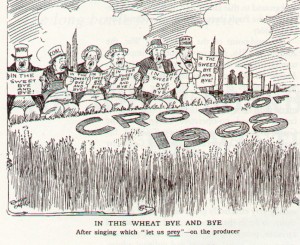
I normally have a bit of time for the Canada West Foundation. Among the various western Canadian think tanks it at least tries for impartiality and some academic rigor in its publications and these are occasionally worth reading.
However, the Canada West Foundation has now strayed deeply into academic fantasy land. Western farmers facing the theft of the seed genetics they have paid for with the passage of the UPOV 91 legislation or the ongoing grain robbery showing up in their grain cheques have a more serious reality to deal with in the here and now.
Argentina moves to protect its wheat farmers
Readers may know that only four countries consistently produce grain for sale in international markets: the US, Canada, Australia, and Argentina. Yesterday Reuters reported that Argentina will be denying export permits to the international grain oligopoly (the so-called ABCD group) because they are not paying Argentinean grain producers a fair share of the world price.
Argentina’s Economy Minister Axel Kicillof, responding to complaints from wheat farmers said “We will only give export permits when the price that these exporters pay the producer is near to the international price.” According to the Minister the giant international grain companies are withholding more than 30% of the international grain price, short-changing farmers.
Western Canadian farmers should be so lucky. We have seen our share of the international wheat price decline from 90% with the single-desk Canadian Wheat Board to around 40%.
So to recap, the Argentinean Economics Minister is punishing the international grain trade because they are taking 30% of the world price for themselves; while the Canadian Agriculture Minister is blathering on about how good western Canadian farmers have it when the international grain trade is taking better than 60% of the world price away from them. New projections that western Canadian farmers could see as little as 20% of the world price as the smaller Canadian grain handling firms are swallowed up by the international oligarchs means more trouble ahead.
So the news from Argentina shows that western Canadian farmers without the Wheat Board are actually worse off than Argentina’s wheat producers. Perhaps we should export Minister Ritz along with the boat load of fairy dust he has been peddling to cover up the consequences of Ottawa’s killing of the farmer-owned and controlled single-desk Canadian Wheat Board.
Private sector cheerleader lands Ottawa funding
Ritz buys more fairy dust for grain farmers
(January 29, 2015) Since the killing of the farmer-controlled Canadian Wheat Board, farmers have lost billions of dollars that have been siphoned into the pockets of the private grain companies – the same companies who have totally bungled organizing quality-assured shipments of wheat and barley to port. There are more and more reports of high-end customers abandoning Canada as a supplier of premium wheat and barley. Facing spring seeding with bins full of grain worth half what it should be even the most trusting western farmers are starting to ask uncomfortable questions.
So what is Ottawa’s response? Minister Ritz announced he was effectively giving three quarters of a million dollars to provide John DePape, one of the most persistent critics of the Wheat Board, with a megaphone to proclaim the virtues of the private trade. Readers might remember how Mr. DePape could be relied upon to claim the Board was not transparent enough compared to the private trade, and soon after the Wheat Board was killed he started to complain that his beloved private trade was not being transparent either. Apparently Mr. DePape now intends to correct this using government money.
This exercise in fantasy will be carried out with much fanfare through a web site called PDQ run by Mr. DePape’s company Farmco and paid for by Ottawa and the Alberta Wheat Commission. It is supposed to “improve farmers’ ability to make well-informed marketing decisions and maximize the value of their crops.” But is such a thing even possible?
Transparency stops at the elevator doorway
The short answer is not really. In fact the grain trade is now entirely private and Mr. DePape has no more privileged access to the grain sales prices of the five giant companies that handle the world’s grain than anyone else does. An astute observer pointed out “transparency stops at the elevator doorway.” These giant companies make most, if not all, their sales directly to their customers behind closed doors.
So how will Mr. DePape undertake to make the opaque transparent? Listening at the trading room doors of the Cargills, Viterras, and Dreyfuses of this world is not much of an option. Perhaps Mr. DePape will employ the same extra-sensory perception he apparently used to determine that whatever the annual audited statements of the farmer-controlled CWB showed, they weren’t showing true numbers?
No matter how much money Ottawa and the trusting Alberta Wheat Commission pour into this web site farmers can be sure the actual sales prices will remain the grain industry’s most closely guarded secret. At least until we have a single-desk Canadian Wheat Board again which is prepared to resume opening its sales books to its farmer-elected Directors and its costs and results in yearly audited statements to producers.
The private grain trade will always exercise its right to remain private. All the efforts of Mr. DePape and others to reinforce the illusion that such a private market can be made open and transparent are pointless – they simply give some farmers the illusion they are marketing their crops, rather than simply taking a price from big grain. No matter what happens an individual farmer can never have the market power to extract anything more from the market place than what the private trade allows them to have.
Instead of calling their web site PDQ, they should really call it CDF “The Office for the Preservation of the Faith” except that the Roman Catholic Church got there first, back in 1542.
Robert Burns Day
(January 25, 2015) I was reminded today is Robbie Burns day when we celebrate Scotland, its most renowned poet, and what he stood for. In western Canada we owe much to the Scottish traders and settlers. The Canadian Wheat Board was an institution largely created by astute Scots who knew more than a thing or two about business and built an institution that served us very well for over 75 years and was effectively killed in 2011 by Ottawa over the objections of most western grain farmers.
I was also reminded that the most expensive single malt ‘scotch’ in the world now comes from Japan – $6000.00 per bottle single malt distilled from Canadian malt barley. Japan used to be a premium market for our barley and no doubt still is, except now that premium goes to the same class of oligarchs which Robbie Burns so despised instead of to the farmers who actually grow the barley.
So raise a glass of the sacred liquor to J. R. Murray, John McFarland, and George H. Mclvor the founding commissioners of the CWB who built such a strong institution for the benefit of western farmers and the many others of their heritage who served and continue to serve western Canada’s farmers with such ability and integrity.
Looking forward to 2015
Aphorisms contain wisdom about the future of grain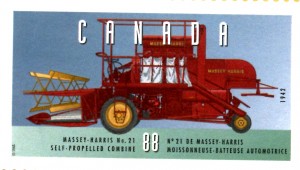
(January 14, 2015) While I was wondering what to put in this space about looking forward to 2015, I received a letter from a long-time friend. Prominent on the envelope’s upper right-hand corner was a postage stamp commemorating the 1942 Massey Harris #21 self-propelled combine. That obsolete machine brought to mind an aphorism often attributed to the 19th century British satirist Oscar Wilde that is particularly applicable to grain farmers – “there is nothing as old-fashioned as the desire to appear modern.”
Perhaps grain farmers are especially inclined to opt for what we see as modern because we are so aware of technological change – our backyards and shelterbelts are often littered with obsolete farm machinery. By the time of the wide-spread adoption of that 1942 combine harvester, Canadian farmers produced nearly 40% of the world’s wheat and had solidified their position of influence in the international grain trade by using freight rate and grain inspection legislation, cooperatives, and the single-desk Canadian Wheat Board to overcome their natural disadvantages of long distances to deep water ports and a globalized oligopoly of grain companies and their agents on the prairies. 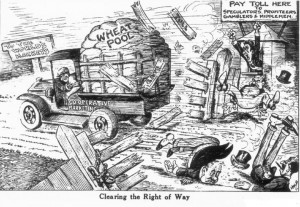
“The more things change the more they stay the same”
Yet in spite of all the technological change since 1942, the structure of the world’s grain trade has hardly changed since the development of the telegraph in the 1850s. The same giant grain companies, many of them still owned by the same families, continue to dominate the international grain trade. Today we know them as the ABCD group (Archer Daniels Midland, Bunge, Cargill, and Louis Dreyfus) plus a fifth commodity trader out of Switzerland known as Glencore that has most of the Canadian grain facilities originally owned by the Wheat Pool Cooperatives built by western farmers and sabotaged by successive Ottawa governments.
One of the more disappointing things about dealing with the small but very vocal anti-Canadian Wheat Board crowd was their determination to ignore the history of their occupation and its implications. Many had swallowed a line that globalization was something new and now that every farmer had a telephone/fax/computer/satellite dish/internet/smart phone, or whatever the latest communications technology of the day was, the world had changed.
Of course the basic economic structure of the grain trade has not changed at all since the 1850s when the ABCD group developed. In consequence those farmers who fell prey to the old aphorism about appearing modern often developed the hubris to think they could actually market their grain better than the collective bargaining of the CWB – a notion grain brokers, the private grain trade, and others with interests in cheap grain, like the Government of Alberta, were all too pleased to cultivate even as these farmers got deeper and deeper into debt.
“Nothing is ever so bad it cannot get worse”
– traditional Norwegian aphorism
For those who did not understand the aphorism about the folly of wanting to appear modern and threw away our market power, western Canadian history offers an illustration of the above Norwegian folk wisdom.
With the single-desk CWB gone, the reality is that western farmers are simply price takers with none of the collective market power we once had. Some farmers still delude themselves that begging for favour from one of the three or so grain companies that have facilities on the prairies amounts to marketing. But the reality is where we once got around 90% of the world grain price, the private trade is now the middle man and has reduced farmers’ share to around 40%. With further consolidation some economists are predicting western farmers will soon be reduced to receiving about 20% of the world grain price.
History shows that even this prediction may be optimistic. When Ottawa took away the 1921 single-desk wheat board, the west saw the rise of larger and larger prairie farms as individuals and investors sought to achieve economies of scale in response to falling grain prices.
Although these Canadian bonanza farms ranged in size from 10,000 acres to the 30,000 acre spread of Charles Nobel near Vulcan and had the benefit of the Canadian Grain Commission, Wheat Pool grain handling cooperatives, and some protection from exploitive rail freight rates, they could not overcome their lack of market power and none of them lasted longer than five years.
Fast forward to today and we have already seen several contemporary bonanza farms fail – one 70,000 acre Saskatchewan based operation leaving creditors holding $46 million in loans. It is no coincidence that without the single-desk Canadian Wheat Board, Canadian wheat is now the cheapest in the world. This brings to mind American comedian Woody Allen’s aphorism that “history may not repeat itself, but it often rhymes.”
So here are my fearless predictions for 2015
- Western Canada will continue to grow the best astro-turf groups in Canada. Readers may recall that astro-turf groups are defined as groups financed by private interests pretending to represent citizens.
- Astro-turf groups like Cereals Canada, having only three actual western farmers sprinkled on its industry-controlled Board of Directors, will continue to lobby for turning cereal grain genomes over to the agro-chemical companies. They have already succeeded in getting grain marketing turned over to the private sector. Your Alberta check-off dollars at work.
- Speaking of astro-turf groups, the Alberta Wheat and Barley Commissions, along with the Manitoba Wheat and Barley Commission will continue with their counterfeit of democratic representation by making sure farmers never get to vote on their members, unless they are willing to travel hours and hours to attend a public meeting. Their theme song will be “why can’t we all just get along” which translates into “why can’t our corporate patrons just get along to the bank with farmers’ money and resources.”
- Saskatchewan’s government will continue to regret allowing Saskatchewan farmers to actually vote for their Wheat and Barley Commission members through a mail-in ballot and will do their best to undermine the democratic representatives of Saskatchewan wheat and barley producers on the Saskatchewan Wheat and Barley Commissions.
- The falling Canadian dollar will increase the price of commodities, since most of them are priced in US dollars. Look for major contortions from astro-turf groups and their private trade masters to explain why Canadian farm gate prices have not jumped in proportion to the decline in the value of the Canadian dollar.
- Almost nobody will ask what exactly the hundreds of thousands of dollars given to Western Canadian Wheat Growers and the Western Canadian Barley Growers Associations by Agriculture Minister Ritz’s department have been used for.
- Look for a major effort to have the so-called rail freight rate cap removed even though it actually gives an incentive to railways to treat grain shippers fairly and allows the railways to make more money, the more grain they move.
- Look for the ruling on the Friends of the Canadian Wheat Board class action law suit. The Friends already have the go-ahead to make the case for recovering what they see as misallocated Pool Account funds, but will the courts allow them to recover the full value of the Wheat Board farmers built and paid for?
- Don’t expect an audited statement with numbers anytime soon from Ottawa’s CWB.
Canada Post’s stamp commemorating an obsolete combine is something for collectors but unlike that antique Massey Harris combine, the need for a single-desk Canadian Wheat Board never goes out of style in a system that has stayed the same for over 140 years. One hopes that the west’s independent grain farms will not end up being commemorated on a similar postage stamp thanks to the Ottawa empowered anti-Wheat Board crowd peddling an even more obsolete world view.
Looking back on 2014
(January 6, 2015) 2014 has to rank as the year where everything has gone wrong for Agriculture Minister Gerry Ritz and his followers. They promised an era of transparency, freedom, competition, profitability, and efficiency for western Canada’s grain farms hitherto never seen.
EVOLUTION DENIED
What Ritz and his cohorts regarded as stuffy bastions of red tape like the Canadian Wheat Board, the Canadian Grain Commission and many other institutions involved in quality assurance, customer relations, and plant breeding were either swept away or changed beyond recognition. Those who understood these organizations had evolved over the decades to protect farmers and asked for evidence and intelligent analyses of these revolutionary changes were ignored.
FLIPPING REPLACES MARKETING
The 2013/14 crop year was supposed to be when the unregulated marketplace showed its mettle and western farmers prospered. However, the result has been a catastrophe for western grain farmers. Our wheat prices fell by half while the world market stayed steady. From the beginning of the crop year the private railways ran at about 98% capacity moving massive volumes of grain to port yet unprecedented numbers of grain ships waited and customers complained because the private elevator companies were not inclined to get the right grain to the right place at the right time. As many of us warned, the private trade’s only interest is flipping the grain for their profit and the devil takes the rest. Which is just what has happened and now Canadian wheat has gone from premium quality grain to being the cheapest in the world.
There was also the extraordinary phenomena of a Minister of the Crown characterizing those who questioned him and warned of this mess as “part of the tin foil hat crowd.”
FARMERS’ SHARE FALLS
The year has also seen the determination of Ottawa to ignore the implications of this great grain debacle. The numbers are plain that in the first half of the crop year, on number two CWRS wheat alone the grain companies took an extra $1.6 billion out of western farmers’ pockets. The percentage change is even more startling. Based on the audited numbers from the previous Wheat Board compared to the actual numbers of the private trade as reported by Minister Ritz’s own Wheat Board, the farmers’ share of the international price of grain has fallen from just over 90% to around 40%. The prediction is that as smaller Canadian grain handling companies are swallowed up, the western farmers’ share will drop to 20%. Little wonder then that Minister Ritz has refused to table an audited statement for his crippled Wheat Board with any numbers in it.
HOW BIG IS THE RIP OFF ON NON-BOARD GRAINS?
Given this astounding change of fortune for wheat growers, it can be extrapolated the numbers for canola are equally as unfair. Certainly this gives further credibility to those who pointed out the systematic rip off of canola farmers by the unregulated private system and attempted a few years ago to get the industry captured Canola Commissions to address the problem.
GO BIG AND GO BROKE
2014 also saw the playing out of another phenomenon that is cyclical on the prairies – the rise and fall of the mega-farm. Each time the system is either not regulated, as in the 1880s, or deregulated, as in the 1920s and now, some come to the conclusion that if they can only achieve large enough economies of scale, they can prosper growing wheat on the Canadian prairies. 2014 saw the collapse of several of these optimistic operations. As is historically typical, they lasted just long enough for investors to realize that there are as many dis-economies of scale in farming as there are economies.
LAMBS TO THE SLAUGHTER
If Minister Ritz and his followers had not done so much damage and created so much long term misery, I could almost feel sorry for them. However, seeing so many of his followers on various farmer-funded but industry captured Astroturf groups sitting with the industry representatives who have so recently been freed by Ottawa to take all they can from farmers makes his followers look gullible at best. Minister Ritz’s accolades on these Astroturf groups may think the lamb can lay down with the lion, but as one wag observed “the lamb will not get much sleep.”
Next time, looking forward to 2015 – sort of
CTA ruling gives the lie to Ritz grain narrative
(December 20, 2014) Most farmers will remember the wide-eyed assertions of the grain companies and Agriculture Minister Ritz that a bumper crop and incompetent railways were the reason grain ships were piling up on the west coast and farmers could not deliver their grain. They claimed grain prices cut by half were no fault of the grain companies. “Blame the railways – nothing too see here – move on” was the mantra. A mantra dutifully repeated by the stenographers pretending to be commentators and reporters in too much of the media.
That line of reasoning was discredited on a quiet Thursday just before Christmas when the Canadian Transportation Agency (CTA) released its determination of the Western Grain Maximum Revenue Entitlements (MRE) for the 2013-14 bumper crop year. The CTA is an independent, quasi-judicial tribunal with all the powers of a Federal Court to subpoena witnesses, documents, and records. They can and do put people under oath and for those who have participated in one of these processes it is a sobering and very stressful experience.
Each year the CTA examines and audits the railway’s documentation on the amount of grain hauled, where it went and over how many miles. This is all used to determine how much the railways will be allowed to charge western grain shippers for moving grain. For a detailed explanation of the MRE click here
The Transportation Agency ruling found that the tonnage of grain the two railways hauled in 2013-14 was “18.8 percent higher than the western grain volume for the previous crop year.” [Emphasis added] In other words a bumper crop was hauled by bumper railway performance.
Given that 18.8% increase in tonnage hauled, it means the grain companies served themselves very well indeed by taking literally billions of dollars from western farmers while using poor rail service as an excuse to confuse farmers and the media with bogus claims about high basis costs being caused by the railways. The CTA ruling shows the grain company claims were so much cow flop.
As was reported here some months ago, ships waiting, customers complaining, and the terrible damage to our reputation for providing quality assured grain is entirely the fault of the incompetence and greed of the private grain trade. The CTA ruling shows grain was moving and being sold but without the single-desk Wheat Board, the grain companies were taking all the cream and most of the milk. As the smallest players in the system farmer Producer Car shippers were squeezed by both sides.
The CTA ruling also demonstrates that Minister Ritz’s Fair Rail for Grain Farmers Act was more of an attempt to divert attention from the fact the grain companies were ripping off farmers for billions of dollars than to do anything for farmers.
Another part of the CTA’s Ruling found that CN rail had overcharged grain shippers by $4.98 million dollars and gave them 30 days to pay this amount to the Western Grains Research Foundation (WGRF). This follows on penalties in other years of tens of millions paid to the WGRF. All showing that the argument there is no money for public interest plant breeding and research is simply not true. It should be noted this is the argument which is being used by Minister Ritz as an excuse to give away cereal grain genetics to the private sector through a disingenuous process his department announced a few weeks ago.
Lastly, this ruling shows that now is the time for the Canadian Canola Growers Association and the other check-off organizations to stop wasting farmers’ money on overseas junkets, very expensive regulatory stunts, endless media propaganda, along with supporting the industry-captured Cereals Canada in Ottawa – all to provide their Conservative masters with political cover. Instead they should start donating the check-off money they take from farmers to the Western Grains Research Foundation as well. Then farmers’ money could be put to a good use which will directly benefit them.
The December 18, 2014 CTA ruling is certainly a gift to farmers but will the truth contained in its pages catch up to the misinformation spread so thickly in the press over this past crop year?


